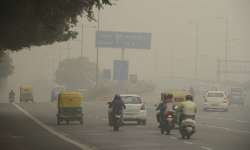NCR air quality 'very poor', to worsen on Wednesday
The safe limit for PM2.5 as per international standards is 25 units, while for national standards, it is 40 units.

Suffering "very poor" air quality, the national capital and the region around it will see rise in the pollution levels till Friday (December 29), officials said on Tuesday.
On Tuesday, the air quality in Delhi was ranked "very-poor", while it was "severe-plus" in Anand Vihar, Ghaziabad and Noida, even as the Central Pollution Control Board (CPCB) saw improvement over the last 24 hours.
However, the air quality in the National Capital Region (NCR) is likely to drop to severe levels due to meteorological reasons, says the weather department forecast.
"India Meteorological Department (IMD) has predicted low winds, poor ventilation coefficient and stable atmospheric conditions likely to cause episodic severe air quality events particularly in the evening and night till December 29," a CPCB statement said.
"In view of this, concerned agencies requested to remain alert and take all necessary measures for preventing emergency situation," the CPCB added.
The Air Quality Index (AQI) of Delhi was recorded 335 on Tuesday against 372 on Monday, both considered "very-poor".
While AQI of Ghaziabad and Noida on Tuesday was 445 and 476 respectively, on Monday, they were 465 and 476, all considered "severe".
The major pollutant PM2.5 or particles in air with diameter less than 2.5 micrometers, at 7 p.m. in Delhi were recorded at 218 units while across NCR, it was 222 units.
Anand Vihar in east Delhi and Delhi Technical University in south Delhi were the most polluted regions with PM2.5 rated "severe-plus" measuring at 336 and 399 units, respectively.
The safe limit for PM2.5 as per international standards is 25 units, while for national standards, it is 40 units.
According to IMD, Tuesday witnessed the wind flow from northwest direction of Delhi which would lead to moderate or dense fog in the morning on Wednesday.
"Atmospheric circulation over Delhi will be less favourable for dispersion of air pollutant," IMD said.
"We are likely to have dense fog, which is natural during these days," a CPCB official said.